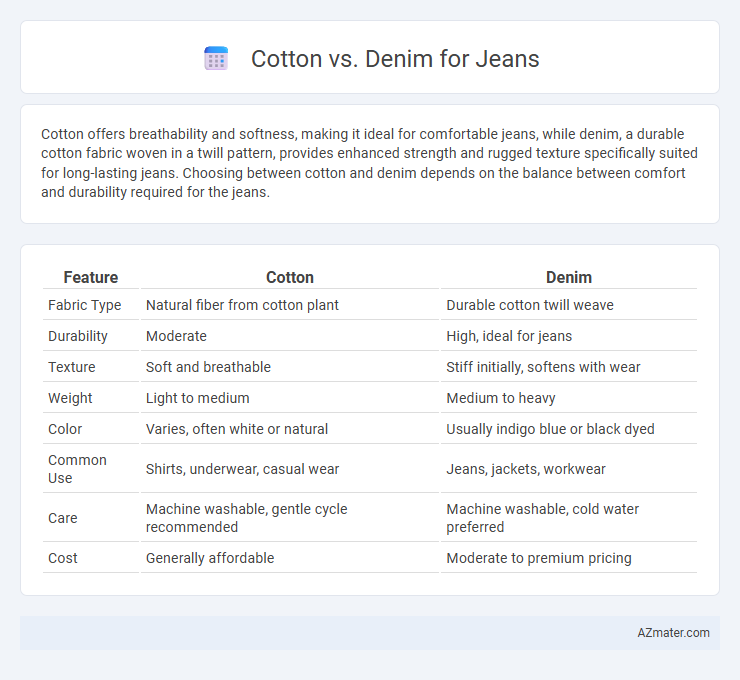Cotton offers breathability and softness, making it ideal for comfortable jeans, while denim, a durable cotton fabric woven in a twill pattern, provides enhanced strength and rugged texture specifically suited for long-lasting jeans. Choosing between cotton and denim depends on the balance between comfort and durability required for the jeans.
Table of Comparison
| Feature | Cotton | Denim |
|---|---|---|
| Fabric Type | Natural fiber from cotton plant | Durable cotton twill weave |
| Durability | Moderate | High, ideal for jeans |
| Texture | Soft and breathable | Stiff initially, softens with wear |
| Weight | Light to medium | Medium to heavy |
| Color | Varies, often white or natural | Usually indigo blue or black dyed |
| Common Use | Shirts, underwear, casual wear | Jeans, jackets, workwear |
| Care | Machine washable, gentle cycle recommended | Machine washable, cold water preferred |
| Cost | Generally affordable | Moderate to premium pricing |
Introduction: Cotton and Denim in Jean Manufacturing
Cotton is the primary natural fiber used in jean manufacturing, prized for its breathability, softness, and durability, making it ideal for comfortable and long-lasting jeans. Denim, a sturdy twill weave fabric primarily composed of cotton, is engineered specifically to enhance resilience and texture, providing jeans with their iconic rugged appearance and strength. The combination of high-quality cotton fibers and the denim weave structure defines the performance, comfort, and aesthetic characteristics essential to premium jeans.
Understanding Cotton: Properties and Uses
Cotton is a natural fiber known for its breathability, softness, and moisture absorption, making it highly comfortable for various clothing applications. Its versatility allows it to be woven into different fabrics, including denim, which is a durable cotton twill fabric commonly used for jeans. Understanding cotton's natural properties helps explain why it is the foundational material in denim production, providing comfort alongside durability.
What is Denim? Key Characteristics
Denim is a durable, woven fabric typically made from 100% cotton or a cotton blend, characterized by its twill weave pattern that creates a distinct diagonal ribbing. This textile is known for its strength, resistance to wear, and classic indigo dye, which fades uniquely over time, enhancing its aesthetic appeal. Denim's heavier weight and sturdiness make it the preferred material for jeans, offering both comfort and long-lasting durability.
Cotton vs Denim: Material Composition Explained
Cotton serves as the primary natural fiber in denim, providing breathability and softness to jeans. Denim is a woven fabric that combines cotton yarns in a twill weave pattern, enhancing durability and texture compared to plain cotton fabric. Understanding the cotton base and denim's unique weave helps explain the distinct feel and sturdiness of jeans.
Comfort Comparison: Cotton Jeans vs Denim Jeans
Cotton jeans offer superior breathability and softness, making them more comfortable for extended wear in warm climates. Denim jeans, typically made from heavy cotton twill, provide durability but can feel stiffer and less flexible initially. Over time, denim molds to the body shape, improving comfort, while pure cotton jeans maintain a lighter, more breathable feel throughout wear.
Durability and Longevity: Which Lasts Longer?
Denim, a sturdy cotton twill fabric, offers superior durability and longevity compared to regular cotton used in jeans, as its diagonal weave structure enhances strength and resistance to wear. While pure cotton jeans provide comfort and breathability, they tend to wear out faster and lose shape more quickly than denim counterparts. Denim jeans typically withstand frequent washing and heavy use better, making them the preferred choice for long-lasting durability.
Style and Versatility: Fashion Perspectives
Cotton offers a softer, more breathable fabric ideal for casual, lightweight jeans, allowing for a wide range of colors and patterns to enhance style flexibility. Denim, a specific type of cotton twill, provides a rugged texture and durability that defines classic jeans, making them a staple in both casual and semi-formal fashion with versatile washes and finishes. The choice between cotton and denim impacts styling options, with denim delivering iconic, timeless looks while cotton expands versatility through comfort and adaptability to seasonal trends.
Care and Maintenance: Cleaning Cotton vs Denim
Cotton jeans require gentle washing with cold water to maintain fabric softness and prevent shrinkage, while denim benefits from infrequent washing to preserve color and texture, often recommended to wash inside out. Using mild detergents helps extend the lifespan of both cotton and denim fabrics by reducing fiber damage and color fading. Air drying is preferable for both materials to avoid heat damage and maintain the jeans' shape and durability.
Sustainability and Environmental Impact
Cotton, especially conventional varieties, requires significant water, pesticides, and land resources, contributing to environmental degradation, whereas organic cotton reduces chemical use and water consumption. Denim, typically made from cotton, inherits these environmental issues but often involves additional water-intensive dyeing and finishing processes that increase its ecological footprint. Sustainable practices in denim production, such as using recycled fibers, eco-friendly dyes, and water-saving technologies, can mitigate environmental impact compared to traditional cotton jeans.
Final Verdict: Which is Better for Jeans?
Cotton and denim both offer distinct advantages for jeans, with cotton providing superior breathability and softness, while denim delivers greater durability and a classic rugged look. Denim, being a woven fabric typically made from cotton, combines strength and texture, making it the preferred choice for long-lasting jeans. For everyday wear and style longevity, denim remains the better option, but cotton jeans can be ideal for comfort and warmer climates.

Infographic: Cotton vs Denim for Jean
 azmater.com
azmater.com